A Method for Extracting Features of the Intrinsic Mode Function’s Energy Arrangement Entropy in the Shaft Frequency Electric Field of Vessels
Abstract
1. Introduction
2. Mechanisms for Generating Shaft Frequency Signals of Vessels
3. Experimental Analysis Based on Feature Extraction of Vessel Shaft Frequency Electric Field Signals
3.1. System Design and Construction
3.2. Method for Intrinsic Mode Function Extraction of Shaft Frequency Electric Field Signals
- (1)
- Input original time series signal and employ cubic spline interpolation to obtain local maxima and minima, forming the upper and lower envelopes of the signal ;
- (2)
- From the upper envelope , fitted to the sequence of locally very large points, and the lower envelope , fitted to the sequence of locally very small points, find the average value of each extreme point in the sequence, and subsequently demean the raw signal through mean value subtraction, yielding the centered signal .
- (3)
- Check whether satisfies the IMF conditions. There are two main conditions: firstly, the number of local extremum points and zero-crossings must be equal or differ by one; secondly, at any given moment, the average of the envelope of local maxima and the envelope of local minima must be zero. If the conditions are not met, use signal as a basis and return to step (2) for further screening until the decomposed signal after iterations satisfies the IMF conditions. The first IMF component of the original signal is represented as ;
- (4)
- Subtract the first IMF component from the original signal leaving the residual signal and repeat step (2) for decomposition. Continue this process until the residual signal becomes a monotonic function that cannot be further decomposed. The sum of all IMF components and the residual component is the original signal , i.e.,
3.3. Comparison of Signal Decomposition Algorithms Based on Shaft Frequency Electric Field Experiments
3.4. Adaptive Spectral Energy Detection
4. Signal Feature Extraction Method Based on Intrinsic Mode Function Energy Permutation Entropy
4.1. Permutation Entropy Algorithm Based on Intrinsic Mode Functions
4.2. Permutation Entropy Analysis of Intrinsic Mode Functions
5. Signal Feature Extraction Methods for Different Vessels
5.1. Feature Extraction Based on the PE Values of the IMF with the Highest Energy
5.2. Feature Extraction Based on Multi-Scale Permutation Entropy
5.3. Experimental Data Verification Based on PE of IMF with Maximum Average Energy
6. Verification with Real Vessel Data
7. Conclusions
- (1)
- For the traditional single modal decomposition, the EMD method is more suitable for shaft frequency electric field time-domain signal feature extraction than the three decomposition methods of EWT, EEMD, and ICCEMAND after the comparison of the line spectrum detection methods.
- (2)
- Based on the EMD algorithm, the modal decomposition and entropy value algorithm extract the signal features of the vessel’s shaft frequency electric field. A test system is built to simulate three different vessel shaft frequency electric field signals, and the PE value is analyzed to decrease significantly with the increase in the order of the IMF component after signal decomposition. To distinguish the shaft frequency E-field signals of different vessels, the IMF components are arranged in descending order of energy, and the PE value of the IMF with maximum energy is calculated. After analysis, it was found that the PE values of the three kinds of shaft frequency electric field signals have apparent differences.
- (3)
- Combined with the simulation experiment method, the PE values of the maximum average energy IMF of the three typical vessel shaft frequency electric field signals are used as the characteristic parameter, and 100 samples of shaft frequency electric field signals are taken, respectively, for comparison. The results show that the fluctuation range of the same type of E-field signals is minimal, with similar characteristic parameters. However, the typical parameters of the different kinds of E-field signals differ significantly and are well differentiated. Compared with the PE and MPE values of the original target signals, the PE value of the maximum mean energy IMF as a feature parameter can fully reflect the complexity of the target feature signals and has better discriminability.
Author Contributions
Funding
Data Availability Statement
Conflicts of Interest
References
- Zhang, J.W.; Yu, P.; Jiang, R.X. Research on Target Tracking Method Based on Vessel Electric Field. Acta Armamentarii 2020, 41, 559–566.2. [Google Scholar]
- Wang, J. Research Status of Electric Field of Warvessel and Foreign Electric Field Mine-sweeping Technology. Digit. Ocean Underw. Warf. 2019, 2, 42–46. [Google Scholar]
- Li, S.; Shi, M.; Luan, J.D.; WU, Z.Z. The Feature Extraction and Detection for Shaft-rate Electric Field of a Vessel. Acta Armamentarii 2015, 36, 220–224. [Google Scholar]
- Li, Y.; Tang, B.; Jiao, S. So-slope entropy coupled with SVMD: A novel adaptive feature extraction method for vessel-radiated noise. Ocean Eng. 2023, 280, 15. [Google Scholar] [CrossRef]
- Zhao, H.; Zuo, S.; Hou, M.; Liu, W.; Yu, L.; Yang, X.; Deng, W. A novel adaptive signal processing method based on enhanced empirical wavelet transform technology. Sensors 2018, 18, 3323. [Google Scholar] [CrossRef]
- Yang, H.; Li, L.; Li, G. A new denoising method for underwater acoustic signal. IEEE Access 2020, 8, 201874–201888. [Google Scholar] [CrossRef]
- Yang, J.; Li, Z.L. Theoretical Framework for a Succinct Empirical Mode Decomposition. IEEE Signal Process. Lett. 2023, 30, 888–892. [Google Scholar]
- Zheng, J.; Cheng, J.; Yang, Y. Partly ensemble empirical mode decomposition: An improved noise-assisted method for eliminating mode mixing. Signal Process. 2014, 96, 362–374. [Google Scholar] [CrossRef]
- Colominas, M.A.; Schlotthauer, G.; Torres, M.E. Improved complete ensemble EMD: A suitable tool for biomedical signal processing. Biomed. Signal Process. Control 2014, 14, 19–29. [Google Scholar] [CrossRef]
- Mei, Y.; Wang, Y.; Zhang, X.; Liu, S.; Wei, Q.; Dou, Z. Wavelet packet transform and improved complete ensemble empirical mode decomposition with adaptive noise based power quality disturbance detection. J. Power Electron. 2022, 22, 1638. [Google Scholar] [CrossRef]
- Lucas, C.G.; Gilles, J. Multidimensional empirical wavelet transform. SIAM J. Imaging Sci. 2025, 18, 906–935. [Google Scholar] [CrossRef]
- Gong, J.; Yang, X.; Pan, F.; Liu, W.; Zhou, F. An Integrated Fault Diagnosis Method for Rotating Machinery Based on Improved Multivariate Multiscale Amplitude-Aware Permutation Entropy and Uniform Phase Empirical Mode Decomposition. Shock Vib. 2021, 2021, 2098892. [Google Scholar] [CrossRef]
- Song, S.; Wang, W. Early Fault Detection of Rolling Bearings Based on Time-Varying Filtering Empirical Mode Decomposition and Adaptive Multipoint Optimal Minimum Entropy Deconvolution Adjusted. Entropy 2023, 25, 1452. [Google Scholar] [CrossRef]
- Kushimoto, K.; Obata, Y.; Yamada, T.; Kinoshita, M.; Akiyama, K.; Sawa, T. Variational Mode Decomposition Analysis of Electroencephalograms during General Anesthesia: Using the Grey Wolf Optimizer to Determine Hyperparameters. Sensors 2024, 24, 5749. [Google Scholar] [CrossRef]
- Dai, Y.; Duan, F.; Feng, F.; Sun, Z.; Zhang, Y.; Caiafa, C.F.F.; Solé-Casals, J. A fast approach to removing muscle artifacts for EEG with signal serialization based Ensemble Empirical Mode Decomposition. Entropy 2021, 23, 1170. [Google Scholar] [CrossRef]
- ElSayed, N.E.; Tolba, A.; Rashad, M.; Belal, T.; Sarhan, S. Multimodal analysis of electroencephalographic and electrooculographic signals. Comput. Biol. Med. 2021, 137, 104809. [Google Scholar] [CrossRef]
- Nan, F.; Li, Z.; Yu, J.; Shi, S.; Wu, X.; Xu, L. Prediction of three-dimensional ocean temperature in the South China Sea based on time series gridded data and a dynamic spatiotemporal graph neural network. Acta Oceanol. Sin. 2024, 43, 26–39. [Google Scholar] [CrossRef]
- Xue, C.F.; Hou, W.; Zhao, J.H.; Wang, S.G.; Hou, W. The application of ensemble empirical mode decomposition method in multiscale analysis of region precipitation and its response to the climate change. Acta Phys. Sin. 2013, 62, 10. [Google Scholar]
- Zhang, Z.; Liu, C.; Liu, B. Vessel noise spectrum analysis based on HHT. In Proceedings of the 2010 IEEE 10th International Conference on Signal Processing (ICSP), Beijing, China, 24–28 October 2010; pp. 24–28. [Google Scholar]
- Xie, D.; Hong, S.; Yao, C. Optimized Variational Mode Decomposition and Permutation Entropy with Their Application in Feature Extraction of Vessel-Radiated Noise. Entropy 2021, 23, 503. [Google Scholar] [CrossRef]
- Chen, Z.; Li, Y.; Liang, H.; Yu, J. Improved permutation entropy for measuring complexity of time series under noisy condition. Complexity 2019, 2019, 1403829. [Google Scholar] [CrossRef]
- Li, G.; Bu, W.; Yang, H. Noise reduction method for ship radiated noise signal based on modified uniform phase empirical mode decomposition. Measurement 2024, 227, 114193. [Google Scholar] [CrossRef]
- Yang, H.; Li, Y.; Li, G. Energy analysis of vessel-radiated noise based on ensemble empirical mode decomposition. J. Vib. Shock 2015, 34, 55–59. [Google Scholar]
- Li, Y.; Wang, X.; Liu, Z.; Liang, X.; Si, S. The entropy algorithm and its variants in the fault diagnosis of rotating machinery: A review. IEEE Access 2018, 6, 66723–66741. [Google Scholar] [CrossRef]
- Yao, W.; Hu, H.; Wang, J.; Yan, W.; Li, J.; Hou, F. Multiscale ApEn and SampEn in quantifying nonlinear complexity of depressed MEG. Chin. J. Electron. 2019, 28, 817–821. [Google Scholar] [CrossRef]
- Jiang, R.X.; Wang, J.R.; Zhu, K.; Zhang, J.W. Correlation of Low-Frequency Line Spectrum Characteristics of Underwater Typical Physical Fields of Vessels. J. Unmanned Undersea Syst. 2023, 31, 588–592. [Google Scholar]
- Jiang, R.X.; Shi, J.W.; Gong, S.G. Analysis of signal characteristics of vessel’s extremely low frequency electrical field. J. Nav. Univ. Eng. 2014, 26, 5–8. [Google Scholar]
- Jiang, R.X.; Zhang, J.W.; Chen, X.G. Vessel’s shaft-related electric field mechanism of production and countermeasure technology. J. Natl. Univ. Def. Technol. 2019, 41, 111–117. [Google Scholar]
- Lin, C.S.; Gong, S.G. Vessel Board Physical Fields, 2nd ed.; Weapon Industry Press: Beijing, China, 2007; pp. 233–248. [Google Scholar]
- Zhao, W.C.; Jiang, R.X.; Yu, P.; Zhang, J.W. Detection and Identification of Vessel Shaft-rate Electric Field Based on Line-spectrum Characteristics. Acta Armamentarii 2020, 41, 1165–1171. [Google Scholar]
- Kang, H.; Zhang, X.; Zhang, G. Phase permutation entropy: A complexity measure for nonlinear time series incorporating phase information. Phys. A Stat. Mech. Its Appl. 2021, 568, 125686. [Google Scholar] [CrossRef]
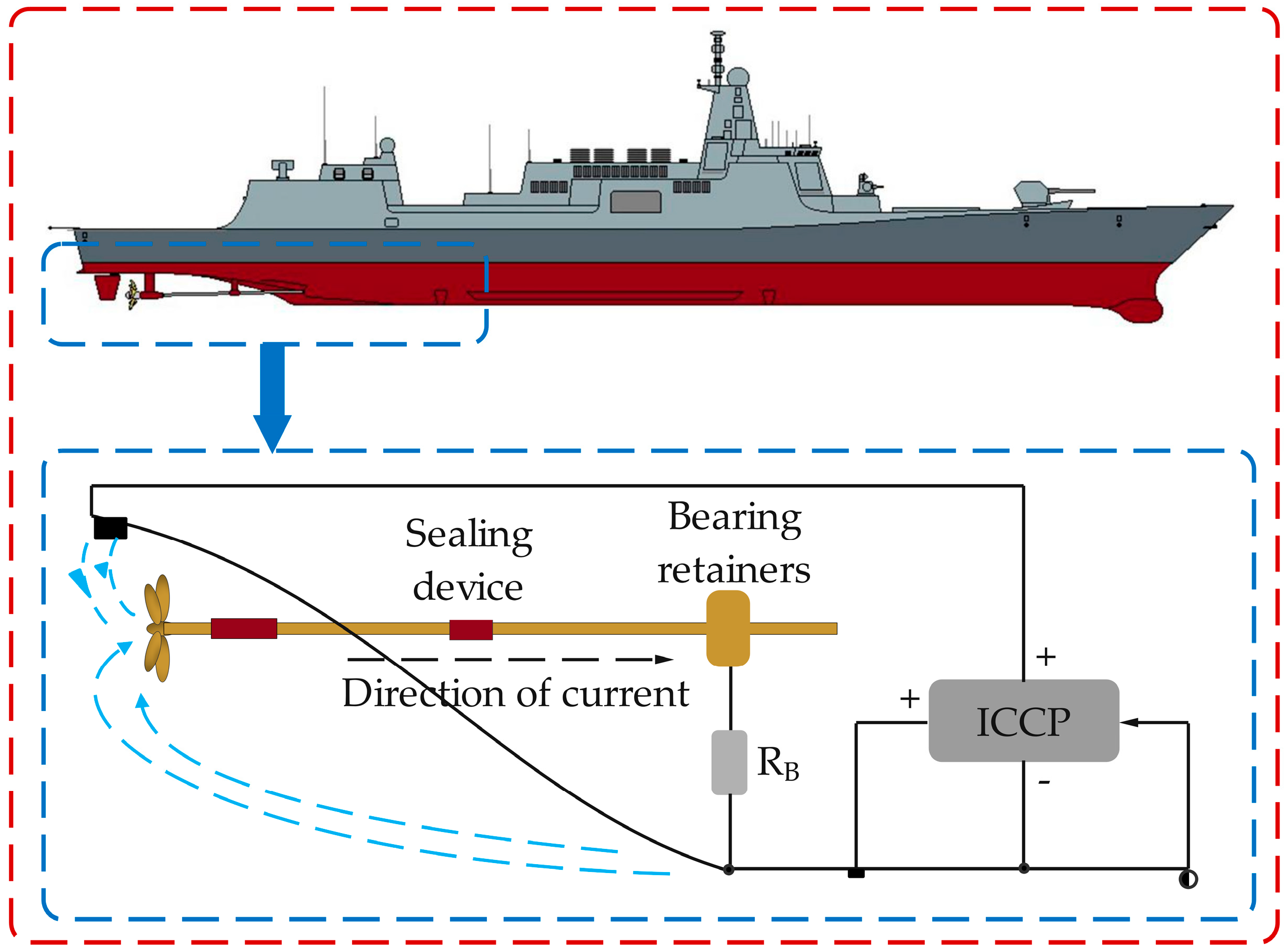

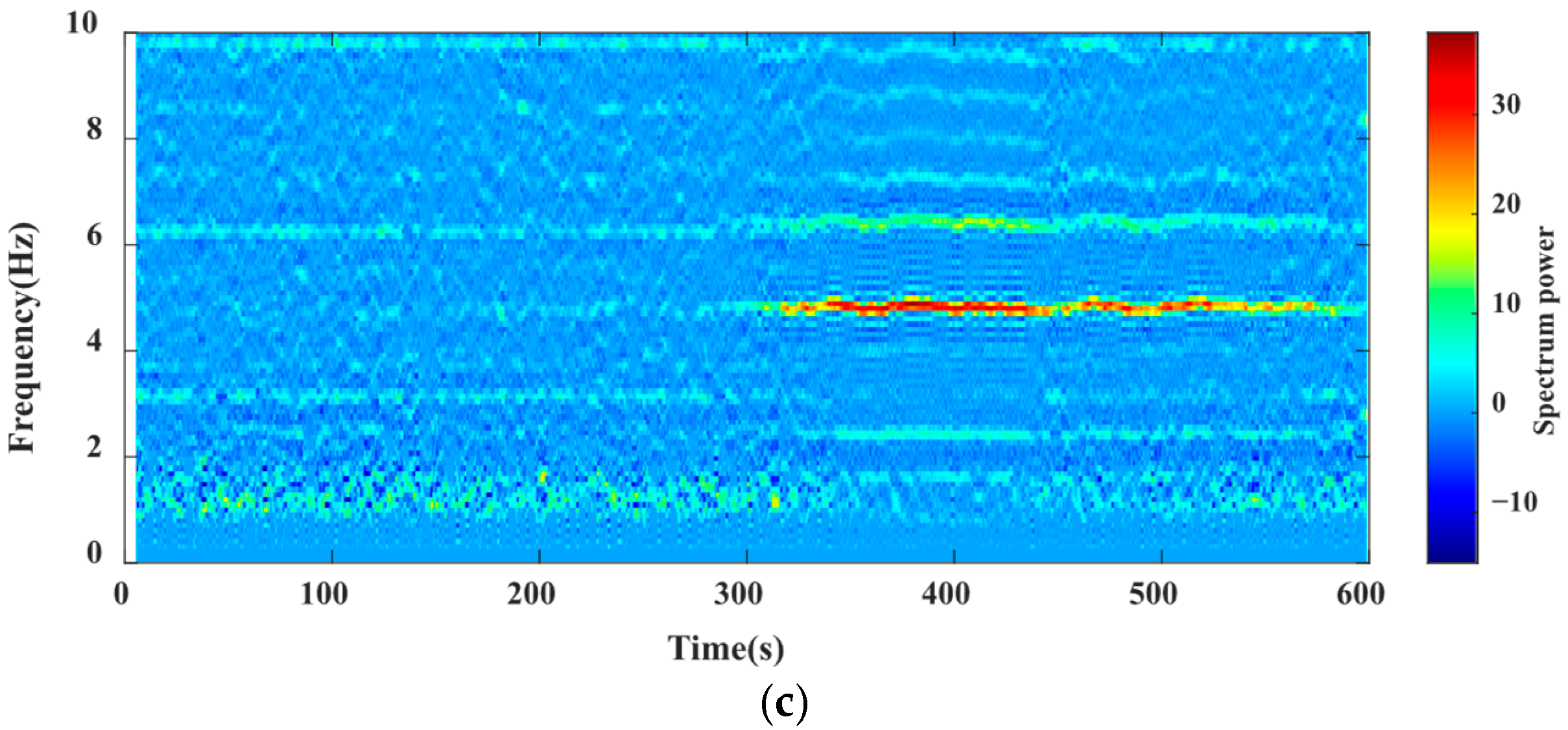

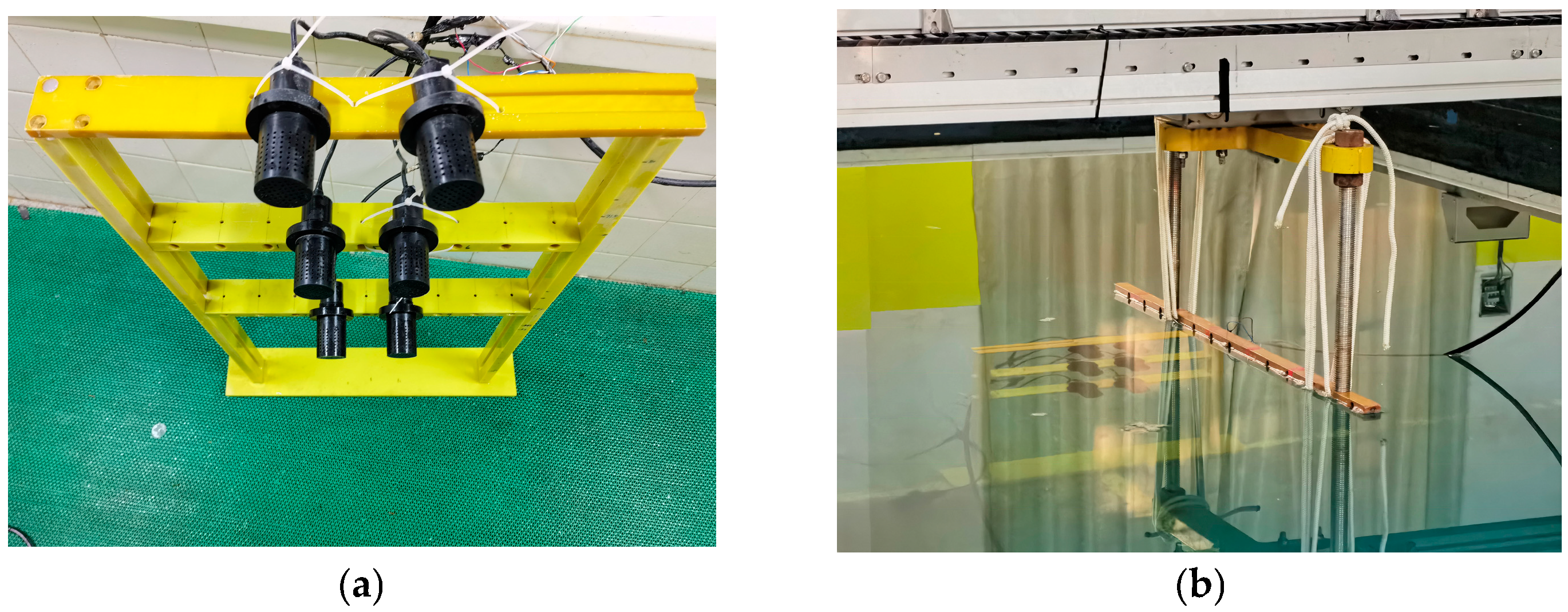
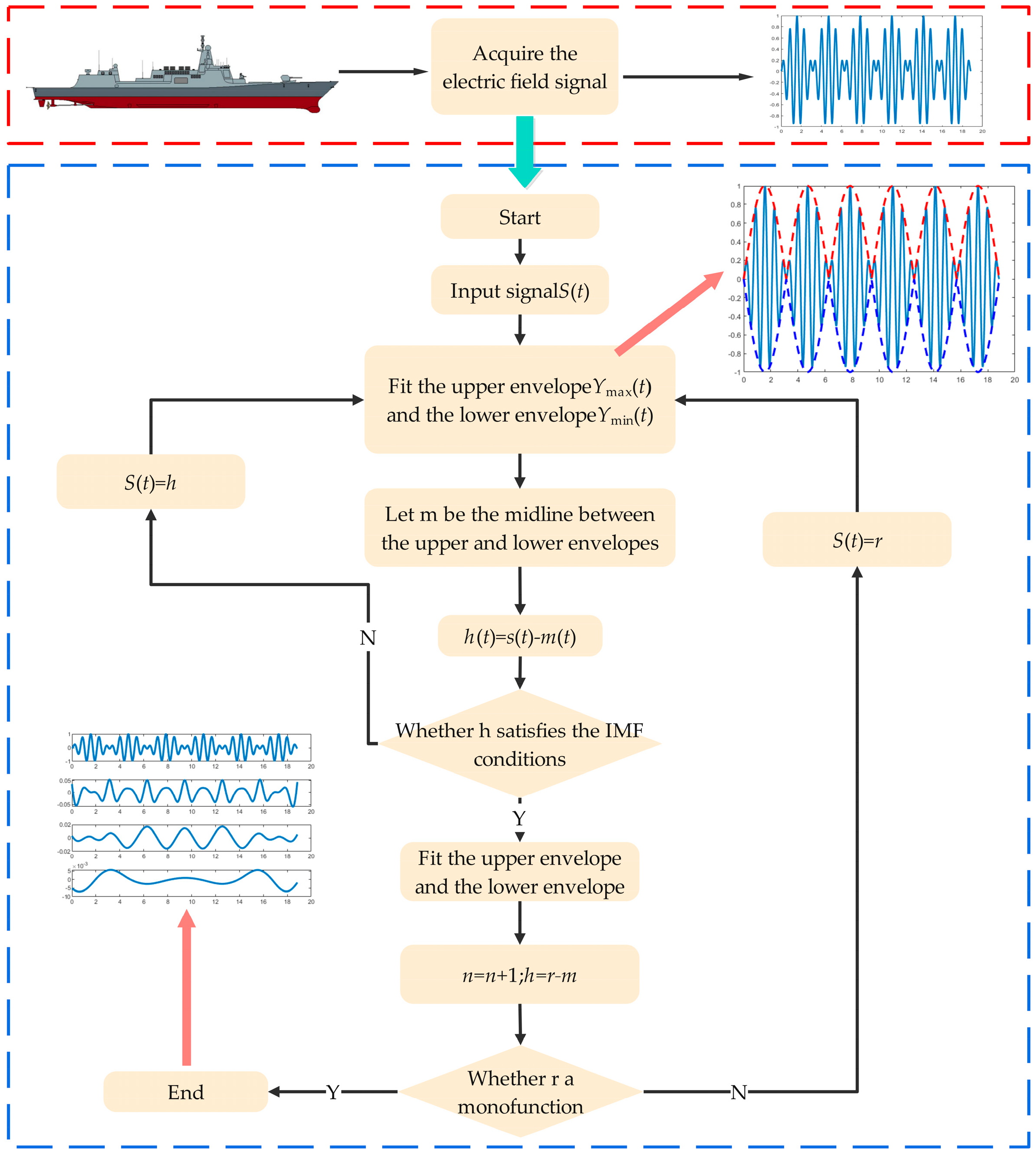
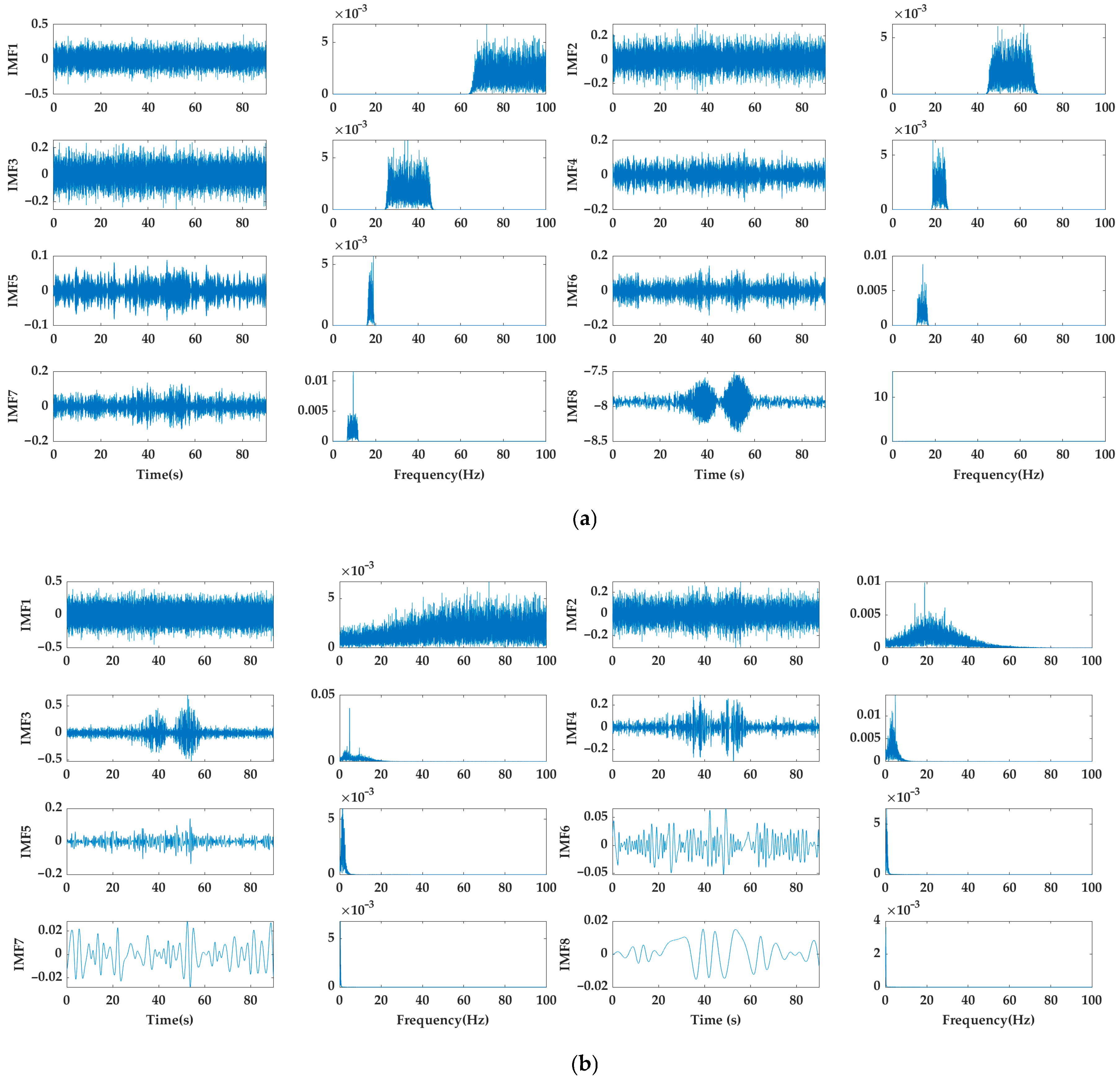
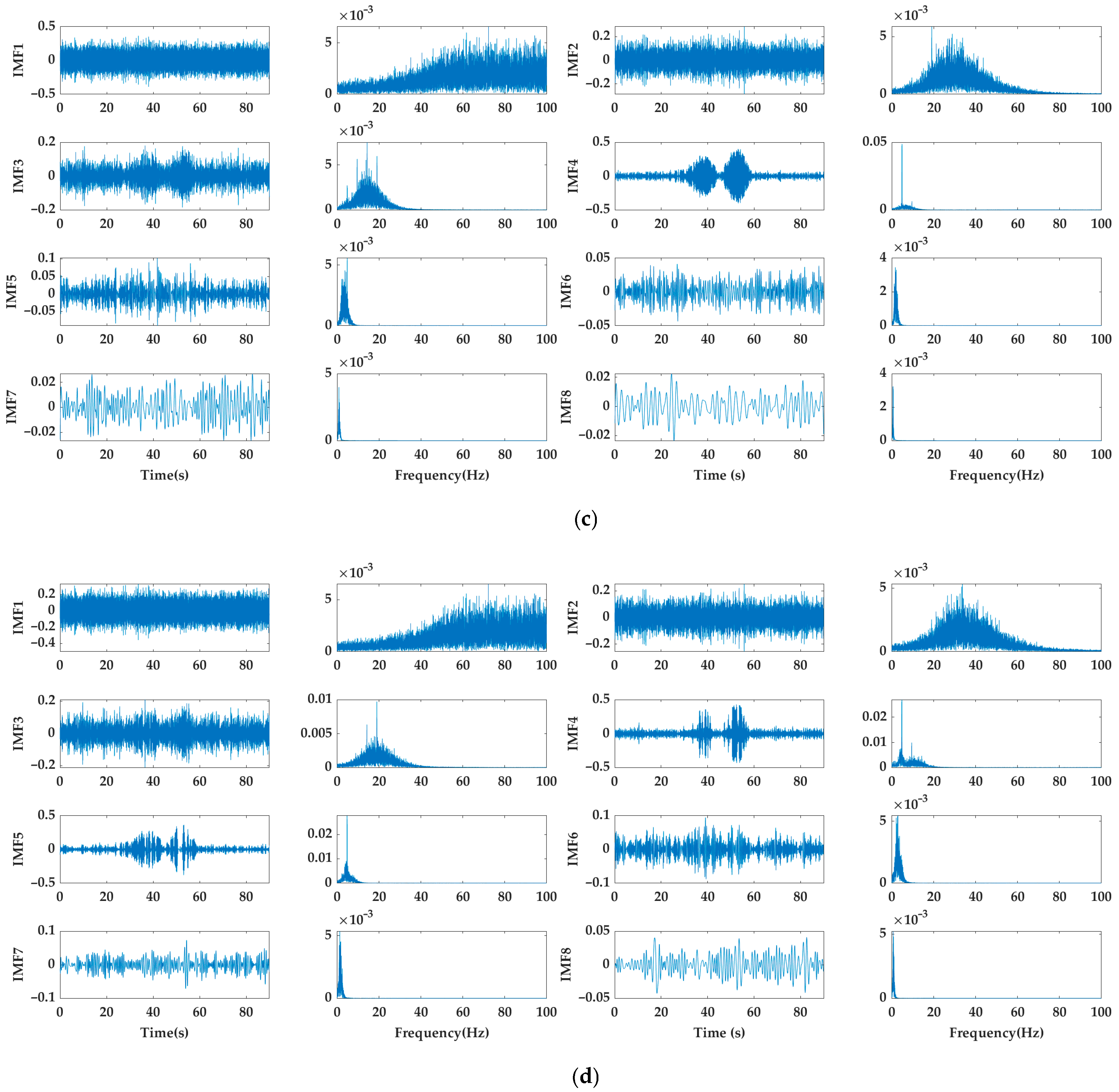

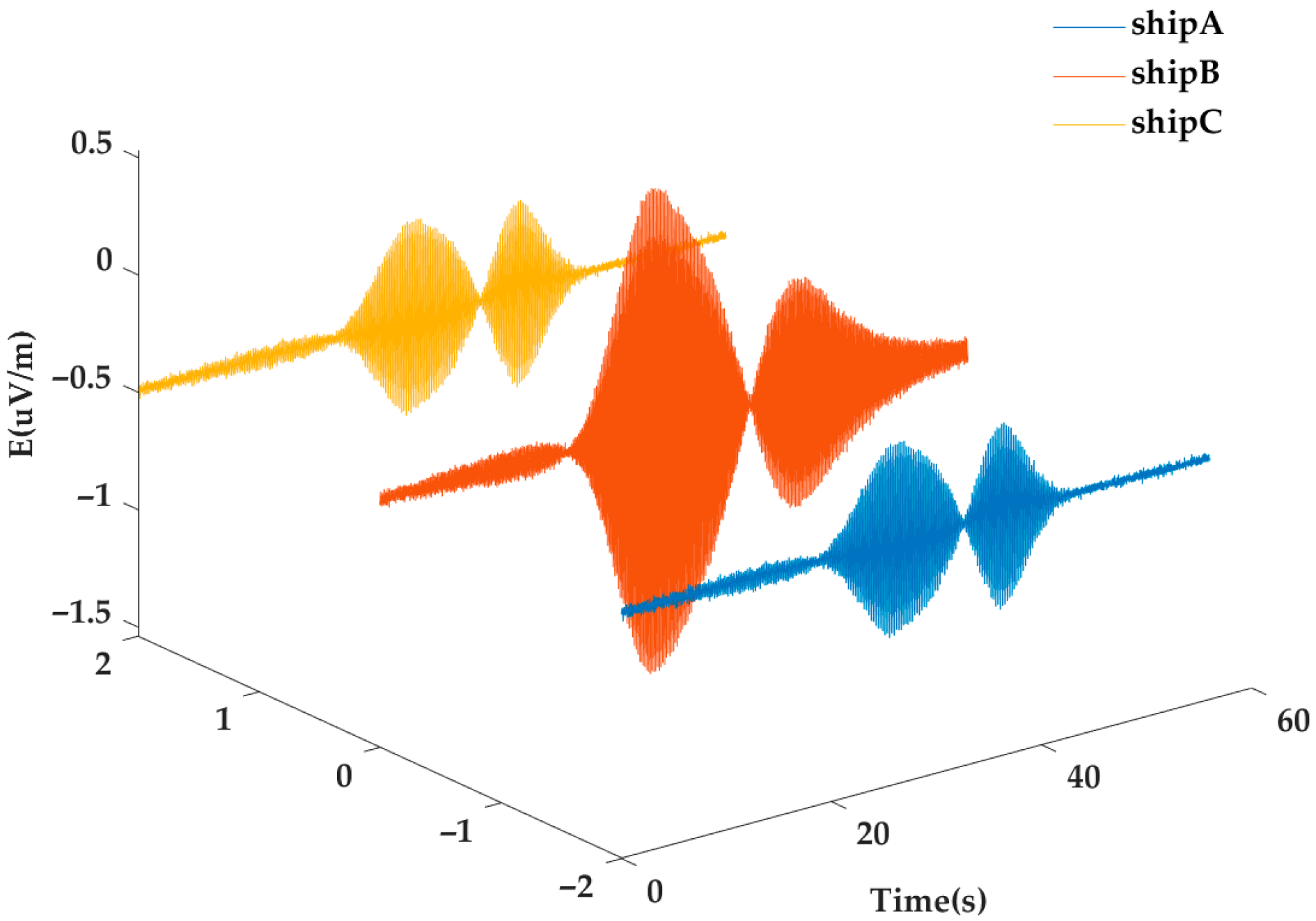
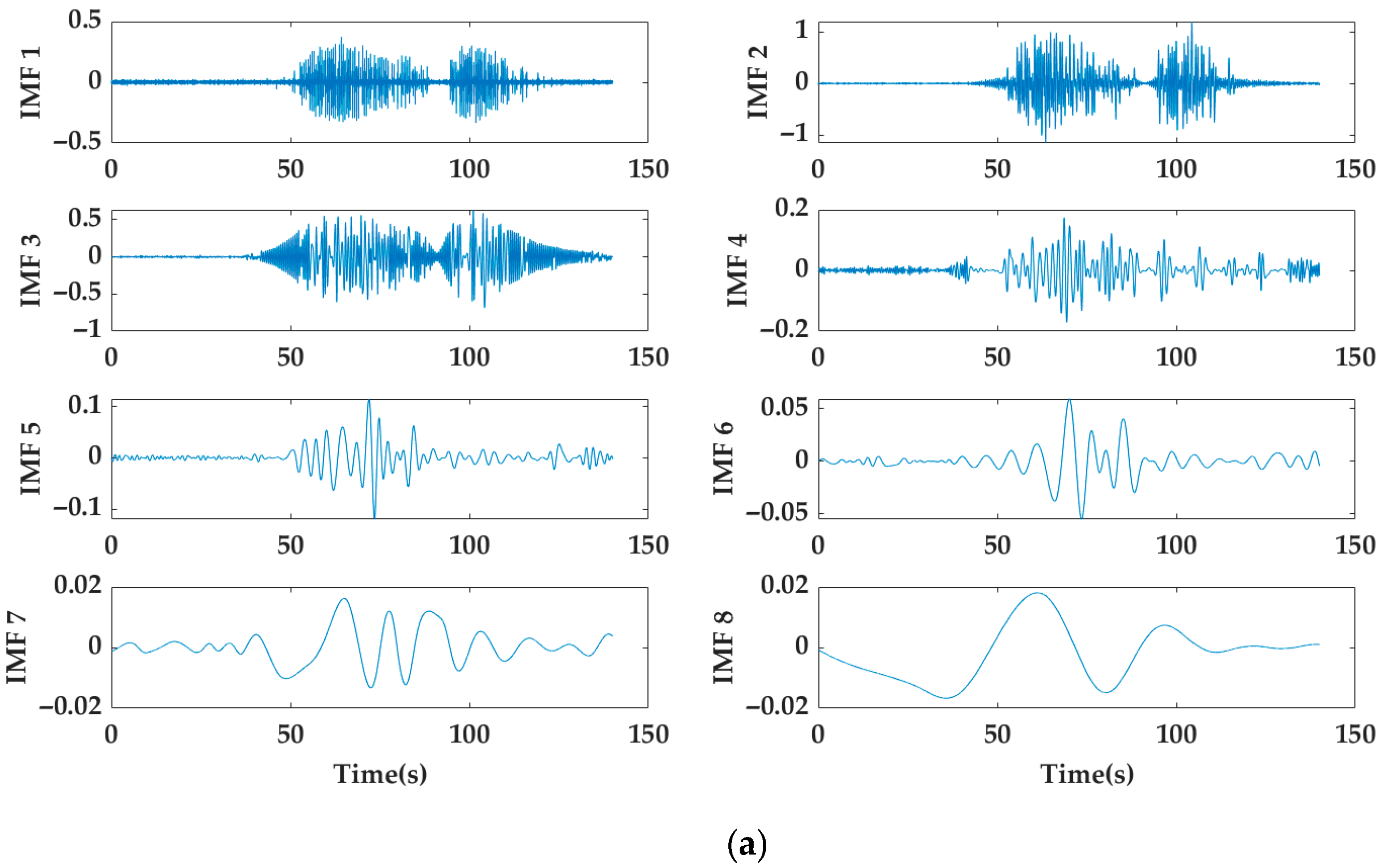



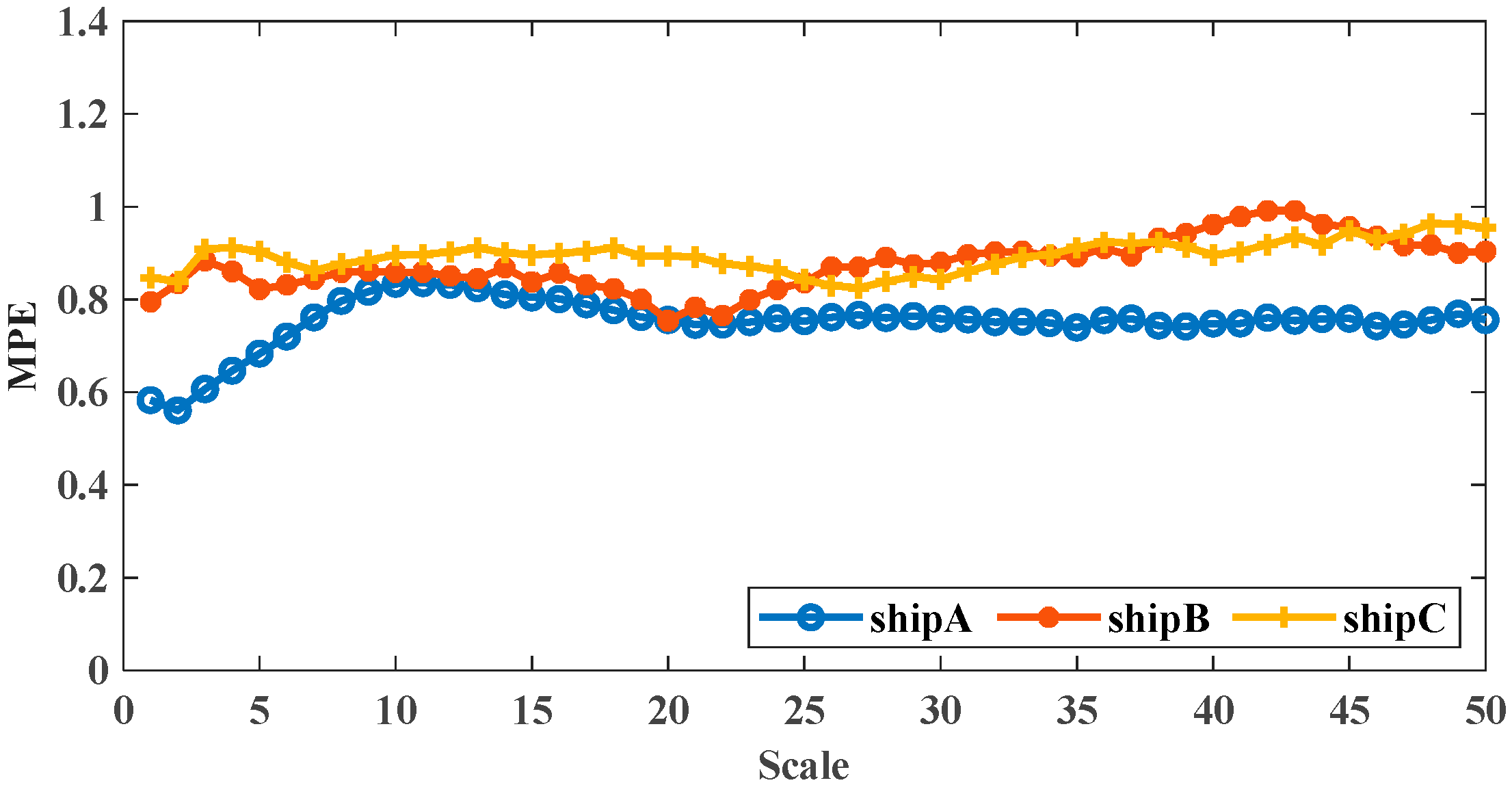



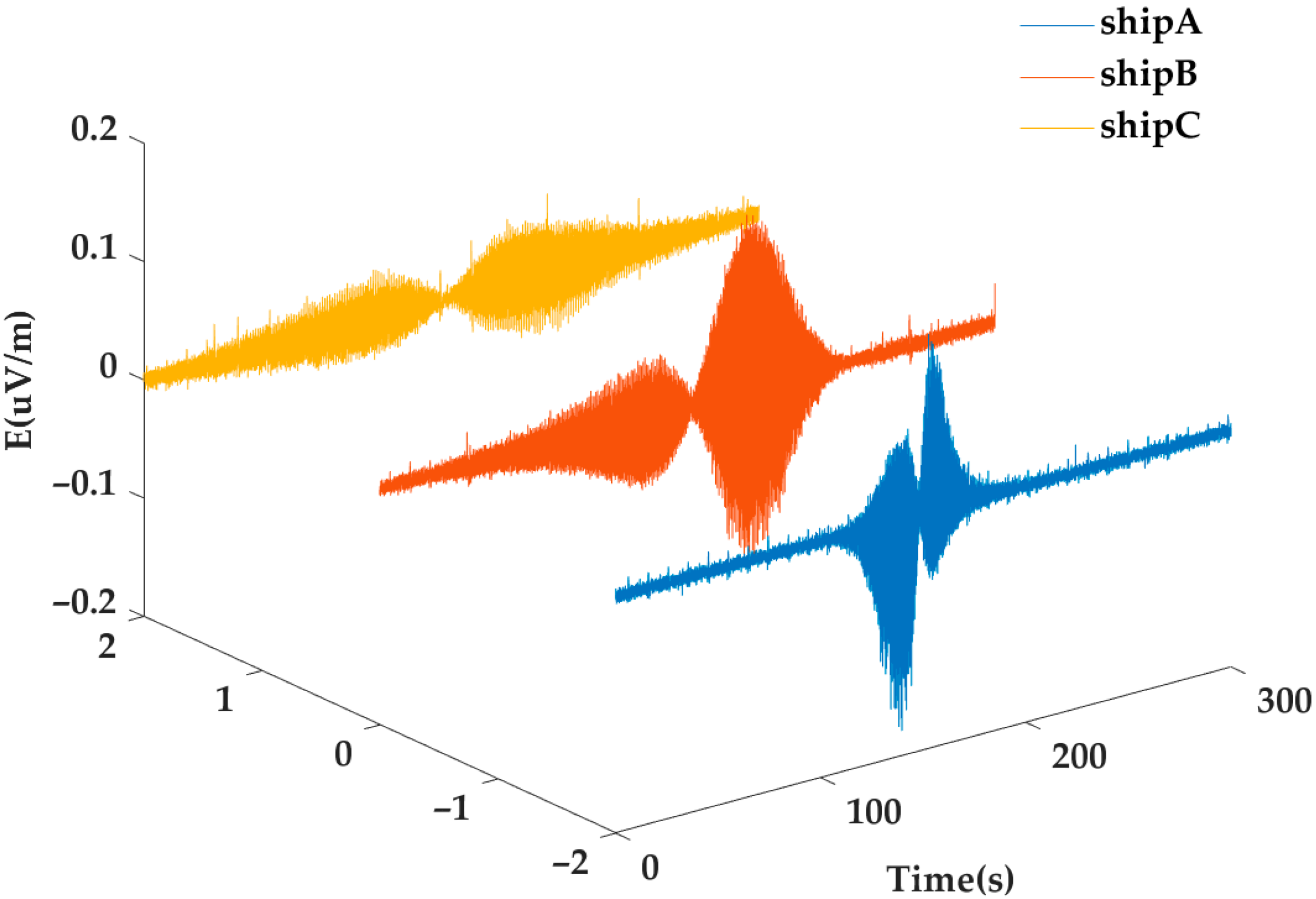
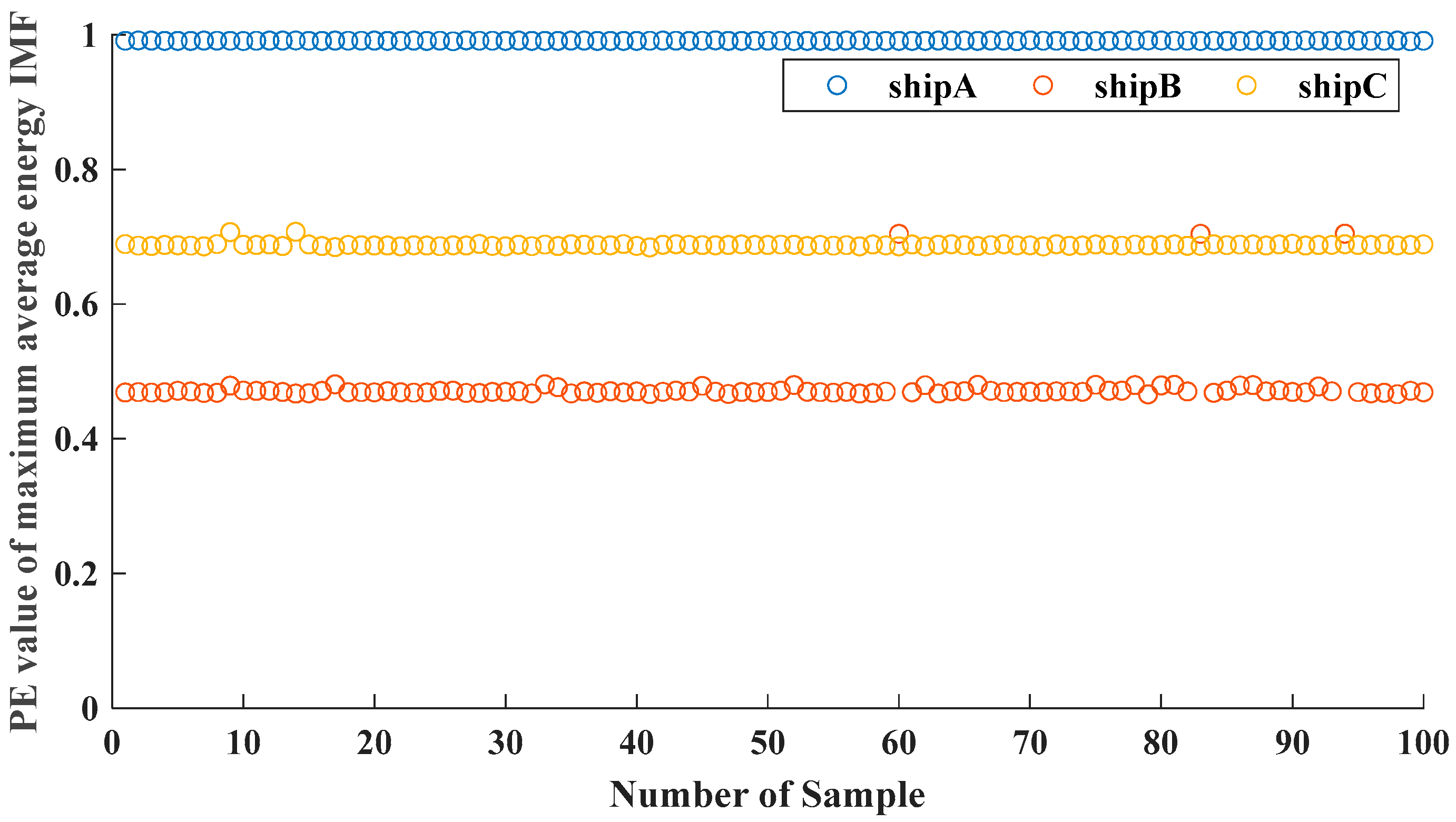
| Vessel A | Vessel B | Vessel C | |
|---|---|---|---|
| Highest Energy Level | IMF2 | IMF2 | IMF3 |
| Average Energy | 0.04727 | 0.0653 | 0.0048 |
| PE Values | 0.6187 | 0.9883 | 0.3934 |
| Vessel A | Vessel B | Vessel C | |
|---|---|---|---|
| Scale = 42 | 0.7611 | 0.9914 | 0.9184 |
| Scale = 43 | 0.7542 | 0.9914 | 0.9344 |
| Serial Number | Vessel Name | Speed (kn) | Orthogonal Distance (m) |
|---|---|---|---|
| Vessel A | BoHaiZuanZhu | 16.8 | 198 |
| Vessel B | TaiCheng29 | 11.7 | 187 |
| Vessel C | ChangXiangLong | 6 | 232 |
| Vessel A | Vessel B | Vessel C | |
|---|---|---|---|
| Variance of PE values for IMF with Maximum Average Energy | 4.5134 × 10−8 | 1.3986 × 10−5 | 8.5552 × 10−8 |
| Range of PE values for IMF with Maximum Average Energy | 0.9909~0.9917 | 0.4667~0.4822 | 0.686~0.69 |
| Variance of PE Values | 8.0481 × 10−9 | 4.2267 × 10−8 | 4.6864 × 10−8 |
| Range of PE Value | 0.9993~0.9997 | 0.9980~0.9989 | 0.9941~0.9952 |
| Variance of MPE Values | 1.4947 × 10−8 | 8.09472 × 10−7 | 4.4766 × 10−7 |
| (Time Scale = 42) | 0.9992~0.9998 | 0.9837~0.9878 | 0.9819~0.9854 |
| Variance of MPE Values | 9.9759 × 10−9 | 1.4209 × 10−6 | 5.6725 × 10−7 |
| (Time Scale = 43) | 0.9992~0.9998 | 0.9811~0.9860 | 0.9836~0.9869 |
Disclaimer/Publisher’s Note: The statements, opinions and data contained in all publications are solely those of the individual author(s) and contributor(s) and not of MDPI and/or the editor(s). MDPI and/or the editor(s) disclaim responsibility for any injury to people or property resulting from any ideas, methods, instructions or products referred to in the content. |
© 2025 by the authors. Licensee MDPI, Basel, Switzerland. This article is an open access article distributed under the terms and conditions of the Creative Commons Attribution (CC BY) license (https://creativecommons.org/licenses/by/4.0/).
Share and Cite
Ma, X.; Sun, Z.; Jiang, R.; Yue, X.; Liu, Q. A Method for Extracting Features of the Intrinsic Mode Function’s Energy Arrangement Entropy in the Shaft Frequency Electric Field of Vessels. Appl. Sci. 2025, 15, 6143. https://doi.org/10.3390/app15116143
Ma X, Sun Z, Jiang R, Yue X, Liu Q. A Method for Extracting Features of the Intrinsic Mode Function’s Energy Arrangement Entropy in the Shaft Frequency Electric Field of Vessels. Applied Sciences. 2025; 15(11):6143. https://doi.org/10.3390/app15116143
Chicago/Turabian StyleMa, Xiaoguang, Zhaolong Sun, Runxiang Jiang, Xinquan Yue, and Qi Liu. 2025. "A Method for Extracting Features of the Intrinsic Mode Function’s Energy Arrangement Entropy in the Shaft Frequency Electric Field of Vessels" Applied Sciences 15, no. 11: 6143. https://doi.org/10.3390/app15116143
APA StyleMa, X., Sun, Z., Jiang, R., Yue, X., & Liu, Q. (2025). A Method for Extracting Features of the Intrinsic Mode Function’s Energy Arrangement Entropy in the Shaft Frequency Electric Field of Vessels. Applied Sciences, 15(11), 6143. https://doi.org/10.3390/app15116143





